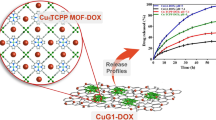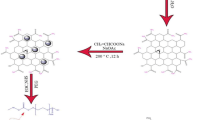Abstract
Graphene oxide has attracted particular interests in drug delivery. The sp2-aromatic structure and abundant oxygen-containing groups of nanoscale graphene oxide (NGO) were frequently utilized to load anti-cancer drugs, resulting in high loading efficiency. This research employed a polyethylene glycol (PEG, PL-PEG(2000)-NH2) functionalized NGO as a drug delivery vehicle for cis-diamminedichloroplatinum (II) (cisplatin, CDDP). The covalent reaction between platinum (II) atom and carboxylic group was utilized to attach CDDP onto NGO-PEG. The NGO, NGO-PEG, and NGO-PEG/CDDP nanohybrids were characterized by atomic force microscope imaging, transmission electron microscope imaging, Fourier transform infrared spectroscopy, and Raman spectroscopy. From the AFM images, the average thickness of the nanohybrids was ranged from 3.4 to 7.0 nm and the average sheet diameter was ranged from 21.7 to 30.5 nm. NGO-PEG demonstrated improved CDDP loading efficiency as high as 0.58 mg mg−1. The NGO-PEG/CDDP nanohybrids released CDDP in a sustained profile for 72 h and demonstrated remarkable cytotoxicity to human breast cancer MCF-7 cells and oral adenosquamous carcinoma CAL-27 cells by in vitro assays. The drug vehicle NGO-PEG was observed nontoxic. The inhibited cell proliferation and morphology deformation induced by NGO-PEG/CDDP were further illustrated by fluorescent images.











Similar content being viewed by others
References
Ajima K, Yudasaka M, Murakami T et al (2005) Carbon nanohorns as anticancer drug carriers. Mol Pharm 2:475–480
Ajima K, Yudasaka M, Maigné A et al (2006) Effect of functional groups at hole edges on cisplatin release from inside single-wall carbon nanohorns. J Phys Chem B 110:5773–5778
Ajima K, Murakami T, Mizoguchi Y et al (2008) Enhancement of in vivo anticancer effects of cisplatin by incorporation inside single-wall carbon nanohorns. ACS Nano 2:2057–2064
Allen TM, Cullis PR (2004) Drug delivery systems: entering the mainstream. Science 303:1818–1822
Bai H, Li C, Wang X et al (2010) A pH-sensitive graphene oxide composite hydrogel. Chem Commun (Camb) 46:2376–2378
Boulikas T, Vougiouka M (2003) Cisplatin and platinum drugs at the molecular level (review). Oncol Rep 10:1663–1682
Brown SD, Nativo P, Smith JA et al (2010) Gold nanoparticles for the improved anticancer drug delivery of the active component of oxaliplatin. J Am Chem Soc 132:4678–4684
Chabner BA, Allegra CJ, Curth GA (1996) “Antineoplastic agents: pyrimidine analogs”. In: Hardman JG et al. (eds) Goodman and Gilman’s the pharmacological basis of therapeutics, 9th edn. New York, McGraw-Hill 1247–1251
Chen W, Yi P, Zhang Y et al (2011) Composites of aminodextran-coated Fe3O4 nanoparticles and graphene oxide for cellular magnetic resonance imaging. ACS Appl Mater Interfaces 3:4085–4091
Ciobotaru CC, Damian CM, Matei E et al (2014) Covalent functionalization of graphene oxide with cisplatin. Mater Plast 51:75–80
da Lee Y, Khatun Z, Lee JH et al (2011) Blood compatible graphene/heparin conjugate through noncovalent chemistry. Biomacromolecules 12:336–341
Depan D, Shah J, Misra RDK (2011) Controlled release of drug from folate-decorated and graphene mediated drug delivery system: synthesis, loading efficiency, and drug release response. Mater Sci Eng 31:1305–1312
Dhar S, Gu FX, Langer R et al (2008) Targeted delivery of cisplatin to prostate cancer cells by aptamer functionalized Pt(IV) prodrug-PLGA-PEG nanoparticles. Proc Natl Acad Sci USA 105:17356–17361
Feazell RP, Nakayama-Ratchford N, Dai H et al. (2007) Soluble single-walled carbon nanotubes as longboat delivery systems for platinum (IV) anticancer drug design. J Am Chem Soc 129: 8438
Gabizon AA (2001) Stealth liposomes and tumor targeting: one step further in the quest for the magic bullet. Clin Cancer Res 7:223–225
Geim AK, Novoselov KS (2007) The rise of graphene. Nat Mater 6:183–191
Gillies ER, Frechet JM (2003) A new approach towards acid sensitive copolymer micelles for drug delivery. Chem Commun (Camb) 14:1640–1641
Haxton KJ, Burt HM (2009) Polymeric drug delivery of platinum-based anticancer agents. J Pharm Sci 98:2299–2316
He F, Fan J, Ma D et al (2010) The attachment of Fe3O4 nanoparticles to graphene oxide by covalent bonding. Carbon 48:3139–3144
Hilder TA, Hill JM (2007) Modelling the encapsulation of the anticancer drug cisplatin into carbon nanotubes. Nanotechnology 18:275704
Hu H, Yu J, Li Y et al (2012) Engineering of a novel pluronic F127/graphene nanohybrid for pH responsive drug delivery. J Biomed Mater Res Part A 100:141–148
Kim JH, Kim YS, Park K et al (2008) Antitumor efficacy of cisplatin-loaded glycol chitosan nanoparticles in tumor-bearing mice. J Control Release 127:41–49
Konishi M, Tabata Y, Kariya M et al (2003) In vivo anti-tumor effect through the controlled release of cisplatin from biodegradable gelatin hydrogel. J Control Release 92:301–313
Lee SC, Kim C, Kwon IC et al (2003) Polymeric micelles of poly(2-ethyl-2-oxazoline)-block-poly(epsilon-caprolactone) copolymer as a carrier for paclitaxel. J Control Release 89:437–446
Lei H, Mi L, Zhou X et al (2011) Adsorption of double-stranded DNA to graphene oxide preventing enzymatic digestion. Nanoscale 3:3888–3892
Li X, Huang X, Liu D et al (2011) Synthesis of 3D hierarchical Fe3O4/graphene composites with high lithium storage capacity and for controlled drug delivery. J Phys Chem C 115:21567–21573
Liu Z, Liang XJ (2012) Nano-carbons as theranostics. Theranostics 2:235–237
Liu Z, Robinson JT, Sun X et al (2008) PEGylated nanographene oxide for delivery of water-insoluble cancer drugs. J Am Chem Soc 130:10876–10877
Liu Z, Robinson JT, Tabakman SM et al (2011) Carbon materials for drug delivery and cancer therapy. Mater Today 14:316–323
Maeda H, Matsumura Y (1989) Tumoritropic and lymphotropic principles of macromolecular drugs. Crit Rev Ther Drug Carrier Syst 6:193–210
Makharza S, Cirillo G, Bachmatiuk A et al (2013) Graphene oxide-based drug delivery vehicles: functionalization, characterization, and cytotoxicity evaluation. J Nanopart Res 15:2099
Malik M, Michalska D (2014) Assessment of new DFT methods for predicting vibrational spectra and structure of cisplatin: which density functional should we choose for studying platinum (II) complexes? Spectrochimi Acta A 125:431–439
Martindale W (1996) The extra pharmacopoeia. In: Reynolds JEF (ed), 31st edn. London: Pharmaceutical Press 552
Matsumura Y, Maeda H (1986) A new concept for macromolecular therapeutics in cancer chemotherapy: mechanism of tumoritropic accumulation of proteins and the antitumor agent smancs. Cancer Res 46:6387–6392
Mellman I, Fuchs R, Helenius A (1986) Acidification of the endocytic and exocytic pathways. Annu Rev Biochem 55:663–700
Mizumura Y, Matsumura Y, Hamaguchi T et al (2001) Cisplatin-incorporated polymeric micelles eliminate nephrotoxicity, while maintaining antitumor activity. Jpn J Cancer Res 92:328–336
Nishiyama N, Yokoyama M, Aoyagi T et al (1999) Preparation and characterization of self-assembled polymer-metal complex micelle from cis-dichlorodiammineplatinum (II) and poly(ethylene glycol)-poly(aspartic acid) block copolymer in an aqueous medium. Langmuir 15:377–383
Nishiyama N, Okazaki S, Cabral H et al (2003) Novel cisplatin-incorporated polymeric micelles can eradicate solid tumors in mice. Cancer Res 63:8977–8983
Oberoi HS, Laquer FC, Marky LA et al (2011) Core cross-linked block ionomer micelles as pH-responsive carriers for cis-diamminedichloroplatinum (II). J Control Release 153:64–72
OuYang F, Huang B, Li Z et al (2008) Chemical functionalization of graphene anoribbons by carboxyl groups on Stone-Wales defects. J Phys Chem C 112:12003–12007
Paredes JI, Villar-Rodil S, Martinez-Alonso A et al (2008) Graphene oxide dispersions in organic solvents. Langmuir 24:10560–10564
Pratt WB, Ruddon RW, Ensminger WD et al (1994) The anticancer drugs, 2nd edn. Oxford University Press, Oxford
Ren L, Liu T, Guo J et al (2010) A smart pH responsive graphene/polyacrylamide complex via noncovalent interaction. Nanotechnology 21:335701
Rice JR, Gerberich JL, Nowotnik DP (2006) Preclinical efficacy and pharmacokinetics of AP5346, a novel diaminocyclohexane-platinum tumor-targeting drug delivery system. Clin Cancer Res 12:2248–2254
Riley CM, Sternson LA (1985) Cisplatin analytical profiles of drug substances. Academic Press, New York, pp 77–105
Sun X, Liu Z, Welsher K et al (2008) Nano-graphene oxide for cellular imaging and drug delivery. Nano Res 1:203–212
Tauro JR, Gemeinhart RA (2005) Matrix metalloprotease triggered delivery of cancer chemotherapeutics from hydrogel matrixes. Bioconjug Chem 16:1133–1139
Tripisciano C, Borowiak-Palen E (2008) Cisplatin functionalized single-walled carbon nanotubes. phys status solidi (b) 245:1979–1982. doi:10.1002/pssb.200879558
Tripisciano C, Kraemer K, Taylor A et al (2009) Single-wall carbon nanotubes based anticancer drug delivery system. Chem Phys Lett 478:200–205
vanZutphen S, Reedijk J (2005) Targeting platinum anti-tumour drugs: overview of strategies employed to reduce systemic toxicity. Coord Chem Rev 249:2845–2853
Wang Y, Li Z, Wang J et al (2011) Graphene and graphene oxide: biofunctionalization an applications in biotechnology. Trends Biotechnol 29:205–212
Yan X, Gemeinhart RA (2005) Cisplatin delivery from Poly(acrylic acid-co-methyl methacrylate) microparticles. J Control Release 106:198–208
Yang X, Zhang X, Liu Z et al (2008) High-efficiency loading and controlled release of doxorubicin hydrochloride on graphene oxide. J Phys Chem C 112:17554–17558
Yang K, Zhang S, Zhang G et al (2010) Graphene in mice: ultrahigh in vivo tumor uptake and efficient photothermal therapy. Nano Lett 10:3318–3323
Yang K, Wan J, Zhang S et al (2011) In vivo pharmacokinetics, long-term biodistribution, and oxicology of PEGylated graphene in mice. ACS Nano 5:516–522
Zhang L, Xia J, Zhao Q et al (2010a) Functional graphene oxide as a nanocarrier for controlled loading and targeted delivery of mixed anticancer drugs. Small 6:537–544
Zhang F, Zheng B, Zhang J et al (2010b) Horseradish peroxidase immobilized on graphene oxide: physical properties and applications in phenolic compound removal. J Phys Chem C 114:8469–8473
Zhang J, Zhang F, Yang H et al (2010c) Graphene oxide as a matrix for enzyme immobilization. Langmuir 26:6083–6085
Zhang W, Guo Z, Huang D et al (2011) Synergistic effect of chemo-photothermal therapy using PEGylated graphene oxide. Biomaterials 32:8555–8561
Zhang Y, Nayak TR, Hong H et al (2012) Graphene: a versatile nanoplatform for biomedical applications. Nanoscale 4:3833–3842
Zhu S, Li J, Chen Y et al (2012) Grafting of graphene oxide with stimuli-responsive polymers by using ATRP for drug release. J Nanopart Res 14:1132
Acknowledgments
This work was supported by Sichuan Natural Science Foundation (Grant no. 2014SZ0201) and the Scientific Research Foundation for the Returned Overseas Chinese Scholars (Grant no. 2013-693-11-8) and Science & Technology Program of Sichuan Health Department (Grant no. 120236). Special gratitude was given to the platform for experiment and characterization from State Key Laboratory of Oral Diseases.
Author information
Authors and Affiliations
Corresponding authors
Additional information
Lingyang Tian and Xibo Pei have contributed equally to this work.
Electronic supplementary material
Below is the link to the electronic supplementary material.
Rights and permissions
About this article
Cite this article
Tian, L., Pei, X., Zeng, Y. et al. Functionalized nanoscale graphene oxide for high efficient drug delivery of cisplatin. J Nanopart Res 16, 2709 (2014). https://doi.org/10.1007/s11051-014-2709-3
Received:
Accepted:
Published:
DOI: https://doi.org/10.1007/s11051-014-2709-3




